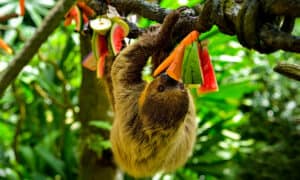Despite only having two species of sloths living today, sloths were one of the most prolific animal species during the Ice Age. With the giant mylodon, who could grow up to ten feet tall and other giant sloth genus’, these animals were not the slow, tree-dwelling, leaf-eating sloths of today.
In a new study from John Hopkins Medicine and Philadelphia College of Osteopathic Medicine, scientists have announced the discovery of a new ground sloth species in the present-day Dominican Republic. Now extinct, they suspect this species was smaller than a black bear and roamed the lowland areas of South America. This sloth did live at the same time as its genus cousins, however those cousins occupied the jungle treetops, while this species is predicted to have lived on the ground.
How Do We Know This Is A New Sloth?
The new sloth species called, parocnus dominicanus, was discovered in a now-underwater sea cave. The cave was once above water and dry. Scientists hypothesize that the sloth climbed into the cave and was unable to get out.
The partial skeleton and bones show anatomical and size differences between the parocnus dominicanus sloth and it’s pleistocene cohort. The bones were much smaller than other fossil records dating around the same age, suggesting that this species was a smaller version of other ancient sloths – remember, these other sloths could be the size of elephants!
In addition, the parocnus dominicanus sloth had anatomical variations in its forelimb and muscle attachments. The deltoid muscle attached to the sloth’s forelimbs at a different place than other discovered and studied species. Researchers suggested this was to provide a wider range of motion.
The deltoid being attached differently shows that this sloth species most likely did more walking on its forearms compared to tree-dwelling cousins. Ground species need more strength in their forelimbs as well as better ability to manipulate their forelimbs in order to survive and thrive on the ground. Researchers believe that these anatomic differences made it possible for the ground sloth to live in the Caribbean lowlands.
Why Are New Sloth Species Important?
Fossil records indicate that sloths were the largest mammal living in South America at the end of the Stone Age. Previous research indicates that sloths were a diverse genus 5,000 years ago; there were giant sloth species stretching across the Americas.
With many sloth species being much larger than present-day sloths, some like the mylodon growing to the size of an elephant, the creatures really did rule the post-Stone Age continent. Studies indicate that these species were faster than present-day species; possibly semi-aquatic living on both land and in the sea; and also omnivores eating both plants and other animals.
How did this prolific and diverse sloth genus evolve into the small, tree-dwelling creatures of today?
By continuing to grow the sloth genus fossil record, researchers can begin to reconstruct the lives of ancient sloths and possibly discover the cause of their extinction and the evolution of today’s slow-moving species. Though humans and giant sloths coexisted in the Americas during the Ice Age, it is unclear whether human hunting habits had any impact on the species.
The discovery of the parocnus dominicanus is another piece in the ancient and giant sloth puzzle. By continuing to learn more about this smaller species, its life, and its adaptations, researchers will be able to learn more about these animals and their place in Earth’s timeline.
The photo featured at the top of this post is © SergioDelgado / CC BY 2.0, Flickr – License / Original
Sources
- , Available here: https://www.sciencedaily.com/releases/2021/10/211012154739.htm
- , Available here: https://www.hopkinsmedicine.org/news/newsroom/news-releases/scientists-report-evidence-for-a-new--but-now-extinct--species-of-ancient-ground-dwelling-sloth
Thank you for reading! Have some feedback for us? Contact the AZ Animals editorial team.






